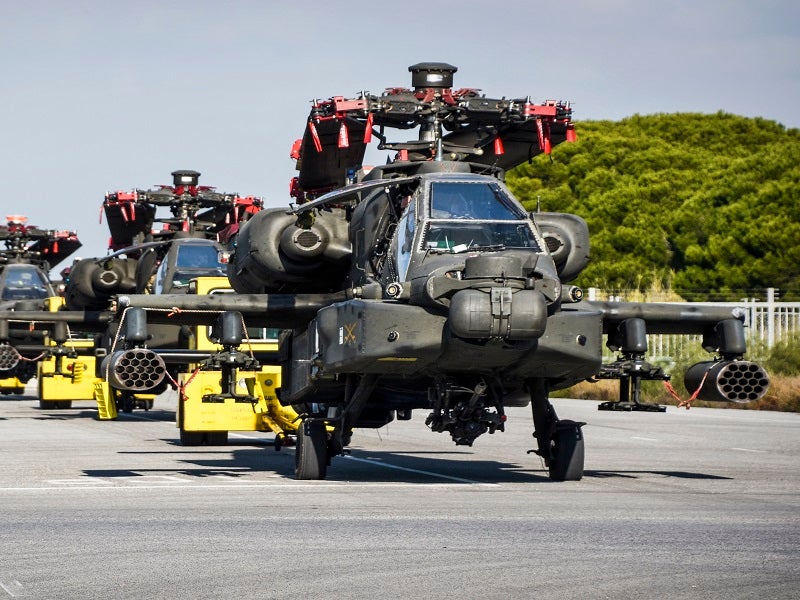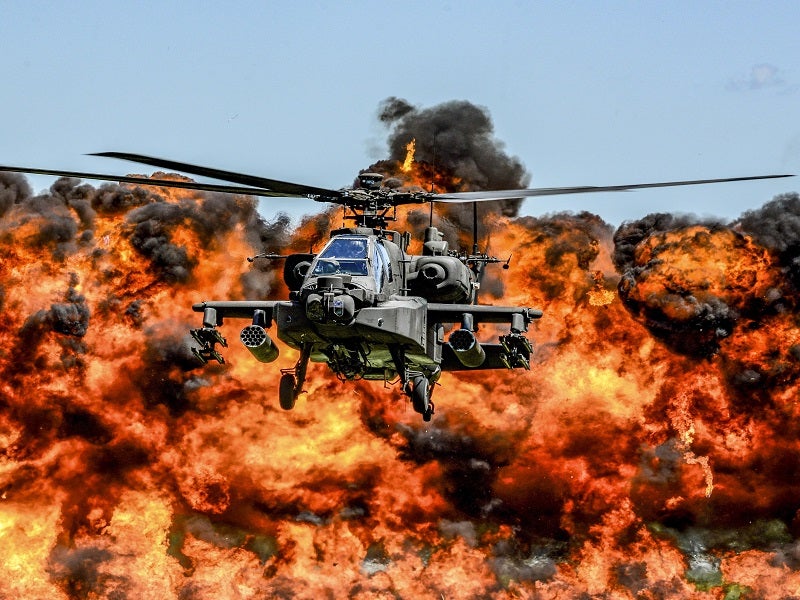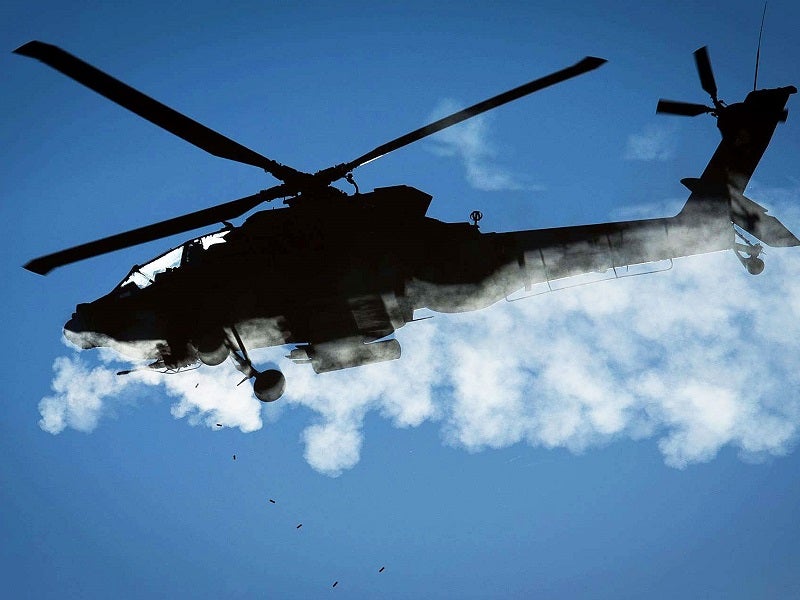The Apache attack helicopter was previously manufactured by McDonnell Douglas, which merged into Boeing in 1997.
The helicopter entered service with the US Army in 1984 and has been exported to a number of countries, including Egypt, Greece, Israel, India, Taiwan, Singapore, Indonesia, the Netherlands, Japan, Korea, Kuwait, Morocco, Saudi Arabia, Qatar, the United Arab Emirates (UAE), and the UK.
Boeing delivered more than 2,700 AH-64 Apache attack helicopters to the US Army and other armed forces. More than 1,275 Apache aircraft are currently in service with the US Army and international forces around the world.
The helicopter completed five million flight hours, including 1.3 million in combat operations, as of March 2023. It was first used in combat in 1989 in the US military action in Panama. The aircraft was used in Operation Desert Storm and supported low intensity and peacekeeping operations worldwide, including in Turkey, Bosnia and Kosovo.
The first Apache AH-64D Longbow was delivered in April 1997 to the US Army. It was deployed by the US Army in Afghanistan as part of Operation Anaconda in support of Operation Iraqi Freedom and, from June 2003, in South Korea.
The AH-64D Longbow is fitted with the Longbow millimetre wave fire control radar and the Longbow Hellfire missile. Boeing upgraded the 501 AH-64A Apaches to AH-64D standard and completed the deliveries in August 2006.
An additional 13 new-build Apaches were initially ordered, along with another 11 in November 2006. The US Army ordered 96 additional remanufactured helicopters in January 2007 and 18 new-build helicopters in April 2007.
During the same year, 30 AH-64Ds were ordered by the UAE. The first new-build AH-64D was delivered to the US Army in June 2007 and the first of the additional remanufactured helicopters in October 2007.
The US Army awarded a $247m contract to Boeing in October 2010 to start low-rate initial production (LRIP) of the AH-64D Apache Block III helicopter. The contract called for the production of 51 AH-64D Apache Block III helicopters for the US Army. The first helicopter under the contract was delivered in October 2011. The Block III was redesignated as AH-64E in 2012.
Tata Boeing Aerospace (TBAL), a joint venture between Tata and Boeing, has been delivering fuselages and secondary structures for AH-64 Apache combat helicopters since June 2018. TBAL manufactures the fuselages at its state-of-the-art facility in Hyderabad, India, and delivers them to Boeing’s AH-64 Apache manufacturing facility in Mesa, Arizona.
Boeing received a contract to build 184 AH-64E Apaches for the US Army and international customers in March 2023.
Apache international orders and deliveries
The Royal Netherlands Air Force received its first AH-64D Apache and first Boeing AH-64D Apache Block III aircraft in May 1998 and May 2012, respectively.
A number of AH-64A helicopters were upgraded to AH-64D standard for South Korea. The company also upgraded a total of 30 UAE Apache helicopters to AH-64D Longbow standard. The deliveries of the upgraded aircraft began in May 2008. In June 2006, Saudi Arabia requested the upgrade of 12 Apaches to the AH-64D standard and, in September 2008, the sale of 12 new AH-64Ds. In October 2008, Taiwan requested the sale of 30 AH-64D Block III Apaches.
In August 2001, the AH-64D was selected by the Japanese Ground Self-Defence Force with a requirement for 55 helicopters. The Apache for Japan is designated AH-64DJP and is armed with Stinger air-to-air missiles.
Kuwait ordered 16 AH-64D helicopters in September 2002. The first was delivered in February 2007. The Kuwaiti Apaches are equipped with BAE Systems HIDAS defensive aids system. In September 2003, Greece signed a contract for 12 (plus four options) AH-64D Longbow, also to be fitted with HIDAS. The first was delivered in January 2007.
In June 2011, Taiwan placed a $2.5bn order for 30 AH-64D Apache block III helicopters. It took delivery of the first six Block III helicopters in November 2013. The delivery of the final batch was completed in 2014. Taiwan’s Apache AH-64E became fully operational in 2018.
In March 2023, Boeing received a $1.9bn contract to deliver 184 AH-64E Apaches for the US Army and international customers, including the Australian Army, the newest Apache customer.
Under the contract, the US Army will receive 115 remanufactured Apaches, with an option to procure additional 15 Apaches. The remaining 54 aircraft will be delivered to partner nations as part of the foreign military sales.
Boeing previously delivered 244 remanufactured Apaches to the US Army and 24 new-build aircraft to an international customer, under a multi-year contract signed in 2017.
AH-64A/D Apache upgrades
The first of the upgraded block II Apaches was delivered to the US Army in February 2003. Block II included upgrades to the digital communications systems of 96 A-model Apaches to improve communications within the ‘tactical internet’. In October 2007, Boeing delivered the first extended block II to the US Army.
In July 2005, the US Army awarded Boeing a development contract for block III improvements, which entered service in 2011. In December 2009, the maiden flight test of AH-64D Apache with block III structures was completed.
Block III includes increasing digitisation, the joint tactical radio system, enhanced engines and drive systems, the capability to control UAVs, and new composite rotor blade. The new blades, which successfully completed flight testing in May 2004, increase the Apache’s cruise speed, climb rate, and payload capability.
The block III system development and demonstration (SDD) contract was awarded to Boeing in July 2006. First flight of the Apache Block III was in July 2008.
Science Engineering Services (SES) is a partner to Boeing in upgrading the AH-64D helicopters to the block III configuration. It was assigned the task of disassembly, inspection, and repair of the AH-64D Apache helicopters.
The disassembly, inspection and repair works take place at the SES West Aviation and Integration Facility in Huntsville. The helicopters are then shipped to Boeing in Mesa, Arizona, to incorporate the AH-64D Apache block III.
In July 2012, Boeing received the first batch of ten new fuselages for block III production. The fuselages were delivered by the long-time supplier Korea Aerospace Industries (KAI).
In April 2016, the US Army returned 117 AH-64 D models to be remanufactured as Apache AH-64E, under a $1.5bn contract.
Apache AH-64E features improved sensors and avionics and is considered to be one of the most advanced multirole combat helicopters in the world.
The UK signed an inter-governmental agreement with the US for the procurement of 50 AH-64Es in July 2016. The first two were delivered to the British Army in November 2020. The UK is expected to receive all the helicopters by 2024.
The AH-64Es will replace the Apache MK1 helicopters that have been in service with the British Army since 2001.
In March 2017, a $3.4bn multi-year agreement was signed between the US Army and Boeing for 268 AH-64E Apaches.
The firm completed the delivery of the 500th AH-64E to the US Army in April 2020.
In June 2020, Morocco placed an order for 24 AH-64E configuration aircraft under the foreign military sales programme. The deliveries are expected to start in 2024.
Boeing completed the delivery of the last five AH-64E helicopters to the Indian Air Force in July 2020. The delivery was part of an order for 22 Apache AH-64E aircraft.
Boeing plans to keep the Apache helicopter operational into the 2060s through improvements and next-generation technologies including modular open systems architecture.
WAH-64 Longbow Apache
A consortium of GKN Westland (now AgustaWestland), Boeing, Lockheed Martin, Northrop Grumman and Shorts bid a version of the Longbow Apache for the UK Army attack helicopter
requirement which was selected in July 1995. Assembly of the WAH-64 Longbow Apache was carried out in the UK by AgustaWestland.
The first helicopter entered service in January 2001 designated as the AH mk1. A total of 67 helicopters were delivered, with the last being formally handed over at the Farnborough Air Show in July 2004.
The initial operating capability was achieved in October 2004 and, in May 2005, the first of three Army Air Corps regiments of 18 helicopters was declared fully operational. The other two regiments became fully operational by 2010. The AH mk1 helicopter has also been operated successfully on HMS Ocean helicopter carrier and, in November 2006, made a first landing on the Invincible Class aircraft carrier, HMS Ark Royal.
Boeing AH-64 Apache weapons
A 30mm automatic Boeing M230 chain gun is located under the fuselage, which provides a rate of fire of 625 rounds a minute. The helicopter has capacity for up to 1,200 rounds of ammunition.
AH-64D is armed with the Lockheed Martin / Boeing AGM-114D Longbow Hellfire air-to-surface missile, which has a millimetre wave seeker that allows the missile to perform in full fire and forget mode. Its range is 8km to 12km.
The Apache attack helicopter can be equipped with air-to-air missiles (Stinger, AIM-9 Sidewinder, Mistral and Sidearm) and the advanced precision kill weapon system (APKWS), formerly known as Hydra, family of guided and unguided 70mm rockets. Plans to arm the Apache with the advanced precision kill weapon system (APKWS) II, a laser-guided version of the Hydra, were shelved in the FY2008 budget. The US Army awarded BAE Systems a development contract for the APKWS II in April 2006.
British Army AH mk1 helicopters are armed with the CRV7 70mm rocket system from Bristol Aerospace of Winnipeg, Manitoba.
The Longbow Apache carries the combination of armaments chosen for the particular mission. In the close support role, the helicopter carries 16 Hellfire missiles on four four-rail launchers and four air-to-air missiles.
The AH-64E Apache helicopters can be equipped with Lockheed Martin’s joint-air-to-ground missile (JAGM) system. The missile system received initial operating capability (IOC) for the US Army’s AH-64E Apaches in March 2019. Lockheed Martin received clearance for full rate production of JAGM in September 2022.
Sensors of Apache attack helicopter
AH-64D Longbow Apache is equipped with the Northrop Grumman millimetre-wave Longbow radar. The Longbow fire control radar incorporates an integrated radar frequency interferometer for passive location and identification of radar-emitting threats. An advantage of the millimetre wave is that it performs under poor visibility conditions and is less sensitive to ground clutter. The short wavelength allows a very narrow beamwidth, which is resistant to countermeasures.
Longbow Apache can conduct an attack in 30 seconds. The radar dome is unmasked for a single radar scan and then remasked. Processors determine the location, speed and direction of travel of a maximum of 256 targets.
The target acquisition designation sight, TADS (AN/ASQ-170), and the pilot night vision sensor, PNVS (AN/AAQ-11), were developed by Lockheed Martin. The turret-mounted TADS provides direct-view optics, television and three-fields-of-view forward-looking infrared (FLIR) to carry out search, detection and recognition, and Litton laser rangefinder / designator. PNVS consists of a FLIR in a rotating turret located on the nose above the TADS. The image from the PNVS is displayed in the monocular eyepiece of the Honeywell integrated helmet and display sighting system (IHADSS), worn by the pilot and co-pilot / gunner.
Lockheed Martin developed a new targeting and night vision system for the AH-64 Apache, using second-generation long-wave infrared sensors with improved range and resolution. The new system is called Arrowhead and has a targeting FLIR with three fields of view, a dual field-of-view pilotage FLIR, a CCD TV camera, electronic zoom, target tracker and auto-boresight.
Arrowhead entered production in December 2003 and the first unit was delivered to the US Army in May 2005. The first Arrowhead system was integrated to the Apache helicopter in June 2005. The 500th delivery was made in 2008 and the remaining deliveries were completed as scheduled. The US Army also placed follow-on contracts for additional Arrowhead fittings to its Apache attack helicopter fleet, increasing the total number of Arrowhead integrations for the US Army.
A contract to equip the UK AH Mk1 helicopters with Arrowhead was placed in May 2005. The first two were delivered in November 2008 and deliveries concluded in 2010.
Apache AH-64A/D countermeasures
The Apache attack helicopter is equipped with an electronic warfare suite consisting of: AN/APR-39A(V) radar warning receiver from Northrop Grumman (formerly Litton) and Lockheed Martin; Lockheed Martin AN/APR-48A Radar Frequency Interferometer Electronic Support target acquisition system; AN/ALQ-144 infra-red countermeasures set from BAE Systems IEWS (formerly Sanders, a Lockheed Martin company); AN/AVR-2 laser warning receiver from Goodrich (formerly Hughes Danbury Optical Systems then Raytheon); AN/ALQ-136(V) radar jammer developed by ITT; and chaff dispensers.
US Army AH-64D Apache Longbow helicopters were to be fitted with the ITT AN/ALQ-211 SIRCM (suite of integrated radio frequency countermeasures) suite. However, the availability of funding for this project is uncertain.
UK AH mk1 Apaches are fitted with BAE Systems helicopter integrated defensive aids suite (HIDAS), also chosen by Kuwait and Greece. HIDAS, which includes the Sky Guardian 2000 radar warning receiver, entered service on the AH mk1 in July 2003.
Israeli AH-64D helicopters are fitted with the Elisra Seraph self-protection system, including SPS-65 missile warner and SPJ-40 radar jammer.
Dutch AH-64D helicopters are fitted with the Northrop Grumman directional infrared countermeasures (DIRCM) pod.
Apache AH-64E configuration
The AH-64E is designed with open systems architecture to support long-term plans to position the platform as a key component of the multi-domain operations (MDO) battlefield. The attack helicopter features the latest navigation, communications, sensor and weapon systems.
Its improved modernised target acquisition designation system provides all-weather target information during day and night. The onboard equipment also provides night vision navigation capability. The upgraded fire control radar also enables the maritime targeting mode for the AH-64E.
Boeing delivered the first AH-64E Version 6 (V6), the most modern configuration of the Apache, to the US Army’s 1-229th Attack Reconnaissance Battalion at Joint Base Lewis-McChord (JBLM) in Washington in January 2021.
The V6 is a network-centric, fully integrated weapon system designed for the MDO battlefield. It provides the capability to gain advantage in highly contested and complex battle environments. The helicopter combines on board and off board sensors, connectivity, and stand-off long-range weapons to ensure current and future joint mission success.
The V6 incorporates Link 16 communications to be able to switch network connections on demand and merge different networks to obtain an operational picture for real-time situational awareness. It also supports the real-time streaming of unmanned aerial systems (UAS) video in the cockpit and provides crewmembers the capability to direct the flight path of the UAS. The software also enables the transmission of information to ground-based systems.
Apache attack helicopter engines
The Apache attack helicopter is equipped with two turboshaft engines, each providing 1,265kW. The American AH-64D is powered by General Electric T700-GE-701 engines and the UK Apache is fitted with RTM322 engines from Rolls-Royce / Turbomeca.
AH-64 Apache performance
The Boeing AH-64 Apache can climb at a rate of 889m/min. The maximum and cruise speeds of the helicopter are 279km/h and 260km/h, respectively. The ferry range and service ceiling of the helicopter are 1,900km and 6,400m respectively. The endurance is three hours and nine minutes. The helicopter weighs around 5,165kg, while its maximum take-off weight is 10,433kg.






